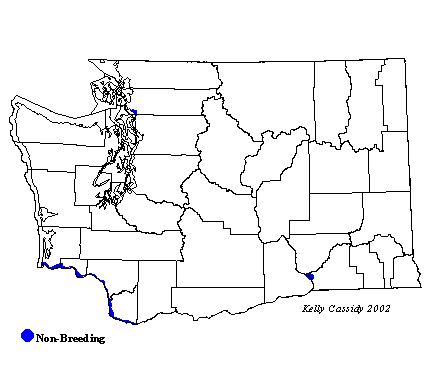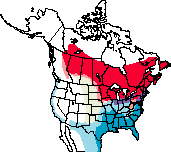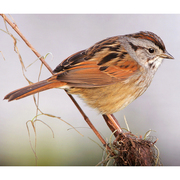Swamp Sparrow
General Description
The Swamp Sparrow with its reddish cap might be confused with the Chipping Sparrow, but the Swamp Sparrow is bigger, bulkier, and occurs in very different habitat. It is a reddish-brown bird with dark stripes down its back. The neck and much of the face are gray, as is the breast. The throat is white and, like the breast, lacks streaks.
Habitat
Swamp Sparrows are seldom found far from water during the breeding season. They usually breed in marshes and brushy swamps with some open water, dense, low vegetation, and perches for singing. They winter in similar habitat, in grassy, weedy, and brushy areas close to water. During migration, they may be seen in wet, weedy fields.
Behavior
Swamp Sparrows are generally solitary birds except during migration, when they often join loose, mixed-species flocks. They often hide in dense cover and forage mostly on the ground, especially at or near the water's edge, sometimes wading into the water. The vocalization is a slow trill, slower than the Chipping Sparrow, with the notes slow enough to count.
Diet
Swamp Sparrows eat both seeds and insects, relying more heavily on insects than do many sparrows. In winter, they eat more seeds and fruits, but more than half of their diet is still composed of insects. In spring and summer, the insect percentage of their diet rises to almost 90%, but then drops in the fall when the majority of their diet may be seeds.
Nesting
The male defends his territory and attracts a mate by singing from a raised perch, often the top of a cattail. The females arrive on the breeding grounds a few days after the males, and the birds form monogamous pair bonds. Most nests are in marsh-vegetation over ground or water, within five feet of the ground. The female builds a nest with a rough, bulky outer layer made of coarse marsh vegetation, and an inner lining of fine grass, sedge, and hair. Dead cattail blades or other vegetation often arch over the top of the nest, forming a side entrance. The female incubates the 3 to 5 eggs for 12 to 14 days, during which time the male may bring food to her on the nest. Both parents help feed the nestlings, which leave the nest at 10 to 13 days. For the first few days after fledging, the young make short flight-hops in the vegetation. Within a week, they can fly from shrub to shrub. The parents continue to feed the young for a few weeks after fledging. Pairs usually raise one or two broods a year.
Migration Status
Swamp Sparrows are generally migratory throughout their range. Wintering primarily in the eastern United States, a few winter and spring transients wander into Washington and other locations throughout the West.
Conservation Status
Destruction of wetlands has resulted in a large loss of habitat for the Swamp Sparrow, but it is still fairly widespread and common across its normal breeding range. Their nests are prone to damage from flooding, often due to nearby development or wetland destruction. Preservation of expansive wetland areas is important to maintain a healthy population of Swamp Sparrows. Until the late 1960s, they were rarely reported in the Northwest. Now they are recorded annually in winter.
When and Where to Find in Washington
Rarely seen from mid-October through March, Swamp Sparrows are reported most often in western Washington at Spencer Island and at the Crescent Lake Wildlife area near Monroe (both in Snohomish County), and the Skagit Wildlife Area (Skagit County). There are some migration and winter records in southeastern Washington and a few other places east of the Cascades.
 Abundance
Abundance
| Ecoregion | Jan | Feb | Mar | Apr | May | Jun | Jul | Aug | Sep | Oct | Nov | Dec |
|---|---|---|---|---|---|---|---|---|---|---|---|---|
| Oceanic | ||||||||||||
| Pacific Northwest Coast | R | R | R | R | ||||||||
| Puget Trough | R | R | R | R | R | |||||||
| North Cascades | ||||||||||||
| West Cascades | ||||||||||||
| East Cascades | R | R | ||||||||||
| Okanogan | R | R | R | |||||||||
| Canadian Rockies | ||||||||||||
| Blue Mountains | ||||||||||||
| Columbia Plateau |
Washington Range Map

North American Range Map


Family Members
 Green-tailed TowheePipilo chlorurus
Green-tailed TowheePipilo chlorurus Spotted TowheePipilo maculatus
Spotted TowheePipilo maculatus American Tree SparrowSpizella arborea
American Tree SparrowSpizella arborea Chipping SparrowSpizella passerina
Chipping SparrowSpizella passerina Clay-colored SparrowSpizella pallida
Clay-colored SparrowSpizella pallida Brewer's SparrowSpizella breweri
Brewer's SparrowSpizella breweri Vesper SparrowPooecetes gramineus
Vesper SparrowPooecetes gramineus Lark SparrowChondestes grammacus
Lark SparrowChondestes grammacus Black-throated SparrowAmphispiza bilineata
Black-throated SparrowAmphispiza bilineata Sage SparrowAmphispiza belli
Sage SparrowAmphispiza belli Lark BuntingCalamospiza melanocorys
Lark BuntingCalamospiza melanocorys Savannah SparrowPasserculus sandwichensis
Savannah SparrowPasserculus sandwichensis Grasshopper SparrowAmmodramus savannarum
Grasshopper SparrowAmmodramus savannarum Le Conte's SparrowAmmodramus leconteii
Le Conte's SparrowAmmodramus leconteii Nelson's Sharp-tailed SparrowAmmodramus nelsoni
Nelson's Sharp-tailed SparrowAmmodramus nelsoni Fox SparrowPasserella iliaca
Fox SparrowPasserella iliaca Song SparrowMelospiza melodia
Song SparrowMelospiza melodia Lincoln's SparrowMelospiza lincolnii
Lincoln's SparrowMelospiza lincolnii Swamp SparrowMelospiza georgiana
Swamp SparrowMelospiza georgiana White-throated SparrowZonotrichia albicollis
White-throated SparrowZonotrichia albicollis Harris's SparrowZonotrichia querula
Harris's SparrowZonotrichia querula White-crowned SparrowZonotrichia leucophrys
White-crowned SparrowZonotrichia leucophrys Golden-crowned SparrowZonotrichia atricapilla
Golden-crowned SparrowZonotrichia atricapilla Dark-eyed JuncoJunco hyemalis
Dark-eyed JuncoJunco hyemalis Lapland LongspurCalcarius lapponicus
Lapland LongspurCalcarius lapponicus Chestnut-collared LongspurCalcarius ornatus
Chestnut-collared LongspurCalcarius ornatus Rustic BuntingEmberiza rustica
Rustic BuntingEmberiza rustica Snow BuntingPlectrophenax nivalis
Snow BuntingPlectrophenax nivalis McKay's BuntingPlectrophenax hyperboreus
McKay's BuntingPlectrophenax hyperboreus

